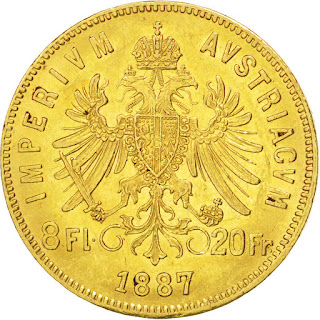Austrian Gold Coins 8 Florins 20 Francs 1887 Emperor Franz Joseph I
In addition to its historical value the Austrian 8 Florin / 20 Francs gold coin is of interest for carrying dual denomination. Bearing mintage dates between 1870 and 1892, each .900 pure coin has an actual gold content of .1867 oz.
The dual denomination was created so the coin could be circulated domestically as 8 Florins and also recognized for pan-European trade worth 20 Francs. In certain ways the Austrian 8 Florin/20 Francs gold coin is the precursor to the present-day Euro.
The obverse bears the right side profile of Emperor Franz Joseph I, ruler of the Habsberg Empire, wearing a laurel wreath crown and heavy whiskers. Surrounding his portrait is the Latin inscription “FRANCISCVS IOSEPHVS I D G EMPERATOR ET REX” translating as "Franz Joseph by the Grace of God, Emperor and King".
The reverse shows the Austro-Hungarian imperial coat of arms framed with the inscription “IMPERIUM AUSTRIACUM” (Empire of Austria). The tail of the coat of arms separates the dual denominationa of 8 Fl. and 20 Fr., with the date appearing at the bottom. The coin's edge is lettered with Franz Joseph I's personal motto “VIRIBUS UNITIS” (With United Forces).
Years: 1870-1892.
Value: 8 Florins / 20 Francs (8).
Composition: Gold.
Fineness: 0.9000.
Weight: 6.4516 g.
AGW: 0.1867 oz.
Diameter: 21 mm.
Thickness: 1.2 mm.
Shape: Round.
Struck by the Austrian Mint.
174 000 exemplaires, KM 2269.
The currency of guilders in the 19th Century was a silver standard, although "Club crowns" from 1858 to 1865 (or 1866) were minted in gold. 1865 France, Belgium, Italy and Switzerland founded the the Latin Union, in which issues of the coins should regarding value, size, weight, etc. should be decided on. Within the Union, all coins should have been valid. Although Austria had signed a preliminary agreement with the Latin Union in 1867, it failed to achieve the required currency conditions for entry into the union. Nevertheless, as of 1870 a 8-guilder piece (= 8 Florin or 20 francs) and a 4-guilder piece (= 4 Florin or 10 Francs) were minted, which resembled the gold coins of the Latin Union. These coins were minted until 1892, the year in which the "crown currency" (English: Corona) was introduced in Austria. These so-called "trade gold coins", which have a premium on the current price of gold, as are gold bullion coins.
Emperor Franz Joseph I
Franz Josef I (English: Francis Joseph) Emperor of Austria, king of Hungary, (1830-1916), born in Vienna. The last significant Habsburg monarch.
Franz Josef was the eldest son of Archduke Franz Karl (Francis Charles), who was brother and heir of Austrian Emperor Ferdinand I. Because his father renounced his right to the throne, Franz Josef became emperor when Ferdinand abdicated near the end of the revolution of 1848.
By the time Franz Josef stepped onto the throne, Austria's position as a European "great power" was already in serious decline. Three external factors furthered Austria's decline.
1. -- Austria's "betrayal" of Russia in the Crimean War (1853-1856) seriously damaged Austro-Russian relations. Lingering Russian ill will was a factor in the July (1914) Crisis which led to the outbreak of WWI.
2. -- The unification of Italy provided a new threat to the empire. In the decade that followed, Austria lost nearly all of its Italian possessions, such as Lombardy and Venetia.
3. -- The rise of Prussian dominance of the German Confederation, and Austria's loss of the Austro-Prussian war in 1866. German unification in 1871 made Austria the lesser of the two German powers.
Austria was weakened by these reverses. Franz Josef had little choice but to negotiate with Hungary on its demands for autonomy. Austria and Hungary agreed to create a dual monarchy in which the two countries would be equal partners. Under the empire of Austria-Hungary, as it was known after 1867, Hungary had complete independence in internal affairs, but the two countries acted jointly in foreign affairs. (This fact contributed to the slowness of A-H's response to the murder of Franz Ferdinand).
The same year, Franz Josef and Elizabeth were formally crowned king and queen of Hungary. (Franz Josef married Elizabeth, daughter of Duke Maximilian of Bavaria, in 1854. They had one son, Rudolf, and three daughters.) As the dual monarch, Franz Josef planned to grant some form of self-government to the Austrian Slavs, but the German and Magyar elites who actually controlled the empire opposed any sharing of power. The resulting dissatisfaction among Austrian Czechs and Serbs further weakened the Habsburg realms and caused increased friction with Russia, which championed the cause of Europe's Slavic peoples.
Franz Josef's later years were marked by a series of tragedies in his family. In 1889 his only son and heir to the throne, Archduke Rudolf, committed suicide; Franz Josef's second younger brother, Karl Ludwig, had died in 1896 from illness due to bad water he drank while on a holy lands pilgrimage; in 1898 Elizabeth was assassinated by an Italian anarchist.
Succession to the Austrian throne was not simple. Following the suicide of Franz Josef's only son Rudolf, the next in succession would have been Franz Josef's younger brother Maximillian. Maximillian, however, had been executed by a firing squad in Mexico in 1867 after a 3 year reign as Emperor of Mexico. Karl Ludwig's oldest son, Franz Ferdinand replaced Rudolf as heir to the throne. Franz Ferdinand was assassinated by a Serbian nationalist in Sarajevo in June 1914. The assasination precipitated a crisis which led to the outbreak of World War I.
Franz Josef died on November 21, 1916. He did not live to see Austria's defeat in the war. His grand nephew, Karl I assumed the throne for two years, but was the last Habsburg monarch.

